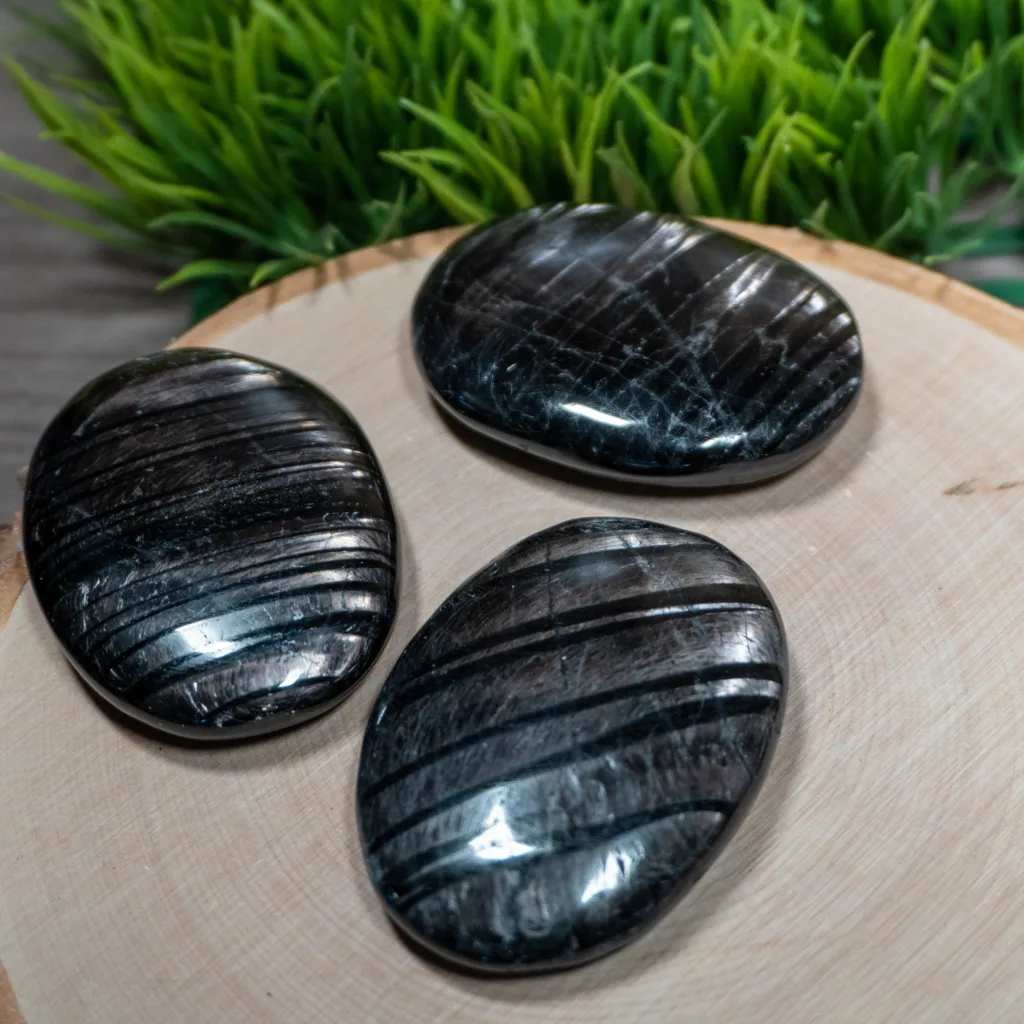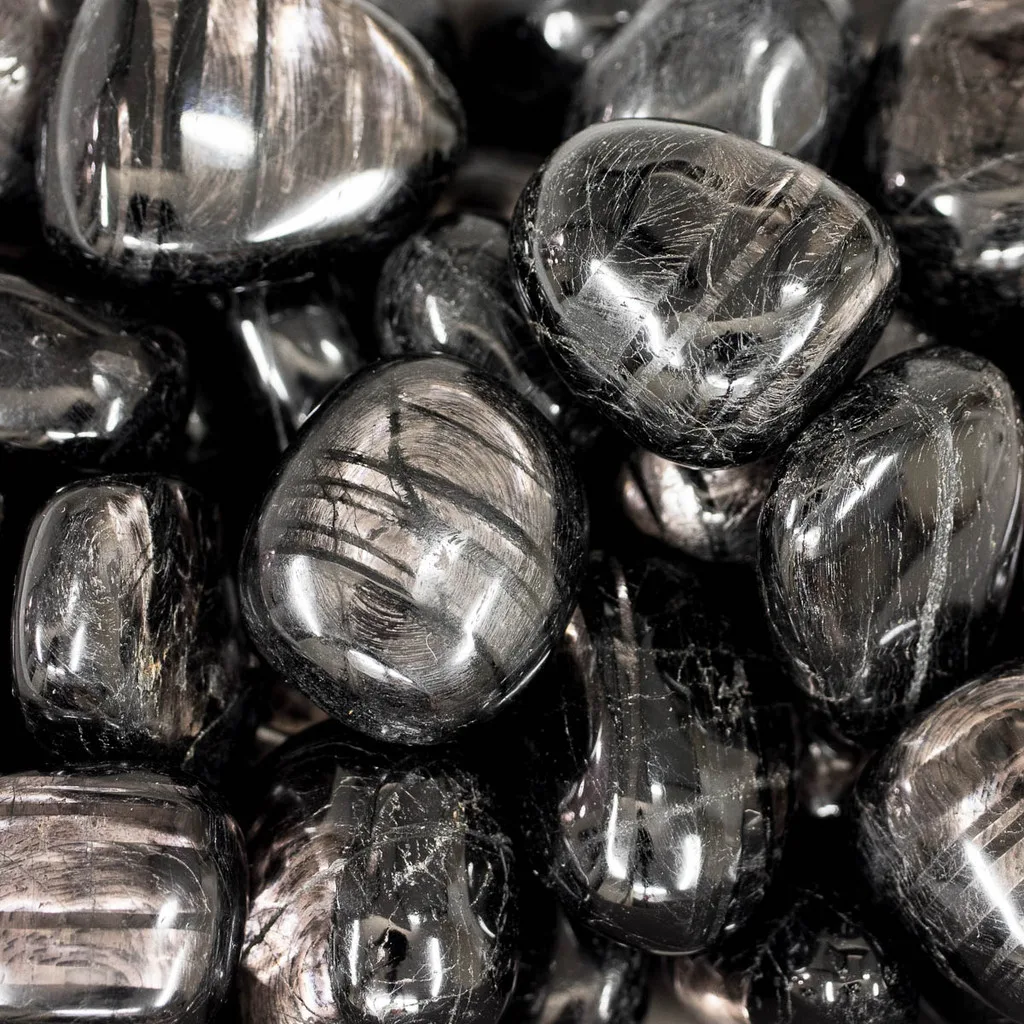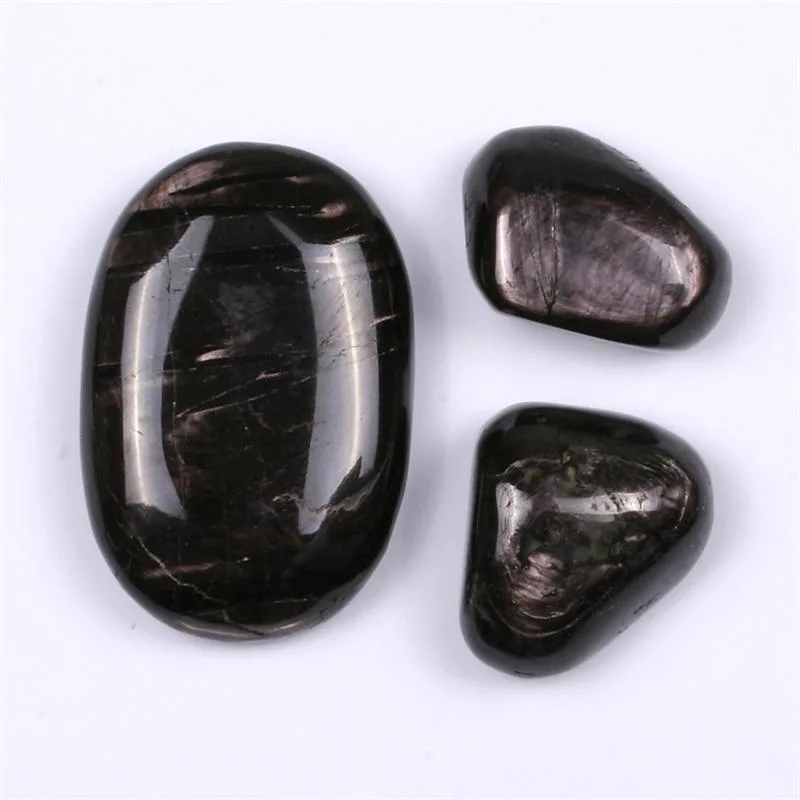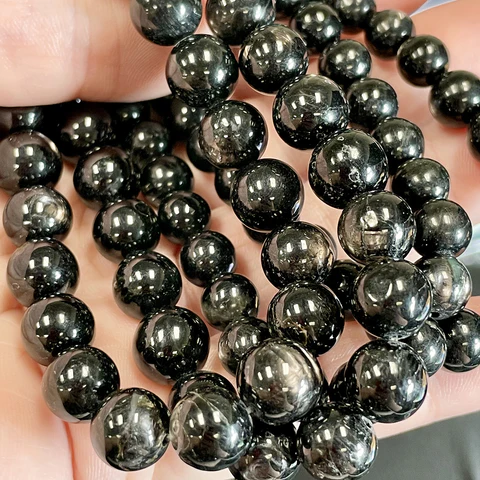Hypersthene is a mineral belonging to the pyroxene group, which is a class of inosilicate minerals commonly found in igneous and metamorphic rocks. Its name is derived from the Greek words “hyper” and “sthenos,” which together mean “over strength” or “excessive strength,” reflecting its strong and resilient nature.


Hypersthene is typically composed of silicate compounds, with the chemical formula (Mg,Fe)SiO3, where magnesium (Mg) and iron (Fe) can both substitute for each other in the crystal lattice. This variability in composition results in a range of hypersthene varieties, with the proportion of magnesium and iron determining the specific mineral’s properties and coloration.
The mineral is characterized by its monoclinic crystal structure and often appears as prismatic or tabular crystals. Hypersthene typically exhibits a metallic luster and ranges in color from grayish-green to brownish-black. It may also display strong pleochroism, meaning its colors change when viewed from different angles.
Hypersthene is a common component in many mafic and ultramafic rocks, such as basalt, gabbro, and peridotite, where it forms alongside other minerals like pyroxenes, olivine, and amphiboles. It is a significant mineral in geology and petrology, providing valuable information about the formation and composition of various rock types. Additionally, hypersthene is used in some jewelry, though it is not as well-known or widely used as other gemstones.
Formation and Occurrence

Hypersthene forms primarily in igneous and metamorphic environments due to its association with mafic and ultramafic rocks. Here are the main processes and settings in which hypersthene is formed and its common occurrences:
- Igneous Rocks Formation: Hypersthene is often found in mafic and ultramafic igneous rocks, including gabbro, basalt, and peridotite. It crystallizes from molten rock (magma) as it cools and solidifies. The presence of magnesium (Mg) and iron (Fe) in the magma is crucial for the formation of hypersthene.
- Metamorphic Rocks Formation: Hypersthene can also develop in metamorphic rocks as a result of high-pressure and high-temperature conditions. It commonly occurs in rocks like eclogite, which undergoes intense metamorphism, where it forms due to the recrystallization of pre-existing minerals.
- Mantle Rocks: Hypersthene is a common constituent of rocks in the Earth’s mantle. Peridotite, which is composed mainly of olivine and pyroxenes, often contains hypersthene. This makes it an important mineral for understanding the Earth’s upper mantle.
- Asteroidal and Lunar Occurrences: Hypersthene has been identified in some meteorites and lunar samples. These extraterrestrial occurrences provide valuable insights into the mineral composition and geological history of other celestial bodies.
- Hydrothermal Alteration: In some cases, hypersthene can form through hydrothermal alteration, where hot, mineral-rich fluids interact with pre-existing rocks, causing changes in mineral composition.
- Mineral Deposits: Although not as common as some other minerals, hypersthene can be associated with certain mineral deposits, especially in ore bodies that contain magnesium and iron.
- As Accessory Mineral: Hypersthene can also occur as an accessory mineral in a wide range of rock types, including certain granites, schists, and other metamorphic rocks. In these settings, it is often not the dominant mineral but rather a minor component.
The formation of hypersthene is intricately linked to the geological processes that shape the Earth’s crust and mantle. It is an essential mineral for geologists and researchers studying the Earth’s history and the composition of rocks in various geological contexts. Additionally, its presence in meteorites and lunar samples contributes to our understanding of the broader solar system’s geological evolution.
Physical, Chemical and Optical Properties

Hypersthene exhibits several distinctive physical, chemical, and optical properties, which are useful for its identification and characterization. Here are some of its key properties:
Physical Properties:
- Crystal System: Hypersthene crystallizes in the monoclinic crystal system, typically forming prismatic or tabular crystals.
- Hardness: It has a moderate hardness of about 5 to 6 on the Mohs scale. This hardness makes it relatively resistant to scratching, but it can still be scratched by harder minerals.
- Cleavage: Hypersthene displays two prominent cleavage planes, which intersect at approximately 87 and 93 degrees. This cleavage can affect the way the mineral fractures.
- Fracture: The mineral often exhibits uneven to conchoidal fracture, which means it may break with irregular and uneven surfaces or curved, shell-like fractures.
- Luster: Hypersthene typically has a metallic to submetallic luster, which can give it a shiny appearance when viewed under proper lighting.
Chemical Properties:
- Chemical Formula: The chemical formula of hypersthene is (Mg,Fe)SiO3, indicating its composition primarily of magnesium (Mg), iron (Fe), silicon (Si), and oxygen (O). The specific proportions of Mg and Fe can vary, leading to different varieties of hypersthene.
- Composition Variability: Hypersthene is a solid solution mineral, meaning that it can contain varying amounts of both magnesium and iron in its crystal structure. The exact composition can affect its color and other properties.
- Streak: The streak of hypersthene is typically white to gray.
Optical Properties:
- Color: Hypersthene exhibits a range of colors, with the most common being grayish-green, brownish-green, or brownish-black. The exact color is influenced by the mineral’s iron content. It can also display strong pleochroism, meaning it shows different colors when viewed from different angles.
- Transparency: Hypersthene is typically translucent to opaque, depending on its thickness and impurities.
- Refractive Index: The refractive index of hypersthene is approximately 1.65 to 1.70, and it can vary depending on the specific variety and composition.
- Birefringence: Hypersthene is birefringent, meaning it can split light into two rays as it passes through the mineral. The degree of birefringence varies with the crystal orientation.
- Optical Character: It exhibits a high relief and is typically found to be of first-order interference color under cross-polarized light.
Hypersthene’s combination of physical, chemical, and optical properties makes it a distinct mineral with unique characteristics that geologists and mineralogists can use to identify and study it in various geological contexts.
Locations of Hypersthene Deposits

Hypersthene is a relatively common mineral in a variety of geological settings, primarily in association with mafic and ultramafic rocks. It is found in various locations around the world. Here are some notable regions and deposits where hypersthene can be found:
- Greenland: Hypersthene is known to occur in parts of Greenland, especially within peridotite and gabbro formations.
- Canada: Various regions in Canada have hypersthene deposits, including parts of Quebec, Labrador, and the Northwest Territories, where it is often associated with the country’s extensive Precambrian shield and mafic/ultramafic complexes.
- Norway: Hypersthene can be found in Norway, particularly in areas with ophiolitic rocks and peridotites.
- Russia: Hypersthene is present in the Ural Mountains and other regions with a history of geological activity. It can occur in ultramafic rocks within these areas.
- United States: Hypersthene is found in several locations in the United States, including California, Arizona, and New York. Some notable occurrences are in the Adirondack Mountains of New York, where it’s associated with the Grenville Province’s rocks.
- Italy: In Italy, hypersthene has been reported in the ultramafic rocks of the Ligurian Alps.
- India: Certain areas in India have hypersthene deposits, often in association with mafic and ultramafic rocks in different parts of the country.
- Antarctica: Hypersthene has also been discovered in parts of Antarctica, mainly in the context of scientific research related to the continent’s geology.
- Asteroids and Lunar Samples: Hypersthene has been identified in meteorites and lunar samples, providing insights into the composition and geological history of these celestial bodies.
These are just a few examples of regions where hypersthene can be found. It’s important to note that the presence of hypersthene is closely linked to specific geological formations and rock types, such as mafic and ultramafic rocks, peridotites, and ophiolites. Geologists and mineralogists often study these locations to gain a better understanding of the mineral and its geological significance.
Application and Uses Areas

Hypersthene is a mineral that, while not as well-known as some other minerals, has several applications and uses in various fields. Here are some of the primary areas where hypersthene finds utility:
- Geological and Petrological Research: Hypersthene is a crucial mineral for geologists and petrologists. Its presence in different rock types, such as mafic and ultramafic rocks, provides valuable information about the formation and history of these rocks. It helps scientists understand the Earth’s mantle composition and tectonic processes.
- Astronomy and Cosmochemistry: Hypersthene has been found in meteorites and lunar samples, contributing to our understanding of celestial bodies. It aids in the study of extraterrestrial geology and the history of the solar system.
- Jewelry: While not a widely used gemstone, hypersthene is sometimes used in jewelry. Its attractive colors and metallic luster make it an appealing choice for collectors and jewelry designers. It is typically cut into cabochons or used as beads in necklaces and bracelets.
- Metaphysical and Healing Properties: Some individuals believe that hypersthene possesses metaphysical properties and healing benefits. It is thought to aid in reducing stress, promoting mental clarity, and enhancing one’s intuitive abilities.
- Educational and Museum Displays: Hypersthene specimens are often included in mineral collections and museum displays to showcase a variety of mineral types and their distinctive properties. They serve as educational tools for students and the general public interested in geology.
- Ornamental and Decorative Objects: Hypersthene can be used for ornamental and decorative purposes, such as in the creation of sculptures, vases, and other artistic works. Its unique appearance can add visual interest to such pieces.
- Historical and Cultural Significance: In some regions, hypersthene may have cultural or historical significance. Indigenous peoples, for example, have occasionally used certain minerals in their traditional practices and artwork.
It’s important to note that while hypersthene has these applications and uses, they are often more niche compared to some other minerals. The mineral’s primary value lies in its scientific and geological significance, both on Earth and in the study of extraterrestrial materials.
Summary of key points about hypersthene

- Definition: Hypersthene is a mineral belonging to the pyroxene group, commonly found in igneous and metamorphic rocks.
- Name Origin: Its name is derived from the Greek words “hyper” and “sthenos,” meaning “over strength” or “excessive strength,” reflecting its durable nature.
- Formation and Occurrence: Hypersthene forms in igneous and metamorphic rocks, particularly in mafic and ultramafic environments, and is also found in meteorites and lunar samples.
- Physical Properties:
- Monoclinic crystal structure.
- Moderate hardness (5-6 on the Mohs scale).
- Exhibits cleavage and uneven to conchoidal fracture.
- Metallic to submetallic luster.
- Chemical Properties:
- Chemical formula: (Mg,Fe)SiO3, with variable compositions of magnesium (Mg) and iron (Fe).
- Commonly associated with other silicate minerals.
- Optical Properties:
- Colors range from grayish-green to brownish-black, with pleochroism.
- Translucent to opaque.
- Birefringent with high relief.
- Locations of Deposits: Hypersthene can be found in various regions around the world, including Greenland, Canada, Norway, Russia, the United States, Italy, and Antarctica.
- Applications and Uses:
- Geological and petrological research.
- Astronomy and cosmochemistry.
- Jewelry and decorative objects.
- Metaphysical and healing properties.
- Educational and museum displays.
- Ornamental and cultural significance.
Hypersthene is a mineral valued for its contribution to geology, especially in the study of mafic and ultramafic rocks, and for its role in understanding extraterrestrial materials. It also has limited uses in jewelry and various ornamental and cultural contexts.




































